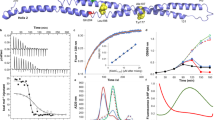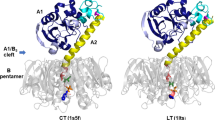Abstract
Bacterial toxins commonly translocate cytotoxic enzymes into cells using channel-forming subunits or domains as conduits. Here we demonstrate that the small cytotoxic endonuclease domain from the bacterial toxin colicin E9 (E9 DNase) shows nonvoltage-gated, channel-forming activity in planar lipid bilayers that is linked to toxin translocation into cells. A disulfide bond engineered into the DNase abolished channel activity and colicin toxicity but left endonuclease activity unaffected; NMR experiments suggest decreased conformational flexibility as the likely reason for these alterations. Concomitant with the reduction of the disulfide bond is the restoration of conformational flexibility, DNase channel activity and colicin toxicity. Our data suggest that endonuclease domains of colicins may mediate their own translocation across the bacterial inner membrane through an intrinsic channel activity that is dependent on structural plasticity in the protein.
This is a preview of subscription content, access via your institution
Access options
Subscribe to this journal
Receive 12 print issues and online access
$189.00 per year
only $15.75 per issue
Buy this article
- Purchase on Springer Link
- Instant access to full article PDF
Prices may be subject to local taxes which are calculated during checkout







Similar content being viewed by others
References
Johnson, A.E. & van Waes, M.A. The translocon: a dynamic gateway at the ER membrane. Annu. Rev. Cell Dev. Biol. 15, 799–842 (1999).
Manting, E.H. & Driessen, A.J.M. Escherichia coli translocase: the unravelling of a molecular machine. Mol. Microbiol. 37, 226–238 (2000).
Berks, B.C., Sargent, F. & Palmer, T. The Tat protein export pathway. Mol. Microbiol. 35, 260–274 (2000).
Koehler, T.M. & Collier, R.J. Anthrax toxin protective antigen — low pH-induced hydrophobicity and channel formation in liposomes. Mol. Microbiol. 5, 1501–1506 (1991).
James, R., Lazdunski, C. & Pattus, F. Bacteriocins, Microcins and Lantibiotics (NATO ASI Series H, Springer, Heidelberg; 1992)
Lazdunski, C.J. et al. Colicin import into Escherichia coli cells. J. Bacteriol. 180, 4993–5002 (1998).
Schein, S.J., Kagan, B.L. & Finkelstein, A. Colicin K acts by forming voltage-dependent channels in phopholipid bilayer membranes. Nature 276, 159–163 (1978).
Cramer, W.A. et al. Structure-function of the channel-forming colicins. Annu. Rev. Biophys. Biomol. Struct. 24, 611–641 (1995).
Gouaux, E. The long and short of colicin action: the molecular basis for the biological activity of channel-forming colicins. Structure 5, 313–317 (1997).
Webster, R.E. The tol gene products and the import of macromolecules into Escherichia coli cells. Mol. Microbiol. 5, 1005–1001 (1991).
James, R., Kleanthous, C. & Moore, J.R. The biology of E colicins: paradigms and paradoxes. Microbiology 142, 1569–1580 (1996).
Pommer, A.J., Wallis, R., Moore, R., James, R. & Kleanthous, C. Enzymological characterization of the nuclease domain from the bacterial toxin colicin E9. Biochem. J. 334, 387–392 (1998).
Oh, J.K., Senzel, L., Collier, R.J. & Finkelstein, A. Translocation of the catalytic domain of diphtheria toxin across planar phospholipid bilayers by its own T domain. Proc. Natl. Acad. Sci. USA 96, 8467–8470 (1999).
Wallis, R. et al. In vivo and in vitro characterization of overproduced colicin E9 immunity protein. Eur. J. Biochem. 207, 687–695 (1992).
Kleanthous, C. & Walker, D. Immunity proteins: enzyme inhibitors that avoid the active site. Trends Biochem. Sci. 26, 624–631 (2001).
Penfold, C.N. et al. A 76 residue polypeptide of colicin E9 confers receptor specificity and inhibits the growth of vitamin B12-dependent E. coli 113/3 cells. Mol. Microbiol. 38, 639–649 (2000).
Wallis, R. et al. Tandem overexpression and characterization of the nuclease domain of colicin E9 and its cognate inhibitor protein Im9. Eur. J. Biochem. 220, 447–454 (1994).
Slatin, S.L., Nardi, A., Jakes, K., Baty, D. & Duché, D. Translocation of a functional protein by a voltage-dependent ion channel. Proc. Natl. Acad. Sci. USA 99, 1286–1291 (2002).
Jakes, K.S., Kienker, P.K. & Finkelstein, A. Channel-forming colicins: translocation (and other deviant behaviour) associated with colicin Ia channel gating. Q. Rev. Biophys. 32, 189–205 (1999).
Raymond, L., Slatin, S.L. & Finkelstein, A. Channels formed by colicin E1 in planar lipid bilayers are large and exhibit pH-dependent selectivity. J. Membr. Biol. 84, 173–181 (1985).
Bullock, J.O. & Kolen, E.R. Ion selectivity of colicin E1. J. Membr. Biol. 144, 131–145 (1995).
Kadner, R.J. In Escherichia coli and Salmonella; Cellular and Molecular Biology 2nd edn Vol. 1 (ed. Neidhardt, F.C.) 58–87 (ASM Press, Washington; 1996).
Kleanthous, C. et al. Structural and mechanistic basis of immunity towards endonuclease colicins. Nature Struct. Biol. 6, 243–252 (1999).
Pommer, A.J. et al. Homing-in on the role of transition metals in the HNH motif of colicin endonucleases. J. Biol. Chem. 274, 27153–27160 (1999).
Wallis, R., Moore, G.R., James, R. & Kleanthous, C. Protein-protein interactions in colicin E9 DNase-immunity protein complexes. Diffusion-controlled association and femtomolar binding for the cognate complex. Biochemistry 34, 13743–13750 (1995).
Pommer, A.J. et al. Mechanism and cleavage specificity of the H-N-H endonuclease colicin E9. J. Mol. Biol. 314, 735–749 (2001).
Falnes, P.Ø., Choe, S., Madshus, I.H., Wilson, B.A. & Olnes, S. Inhibition of membrane translocation of diphtheria toxin A fragment by internal disulfide bridges. J. Biol. Chem. 269, 8402–8407 (1994).
Duché, D., Parker, M.W., González-Mañas, J-M., Pattus, F. & Baty, D. Uncoupled steps of the colicin A pore formation demonstrated by disulfide bond engineering. J. Biol. Chem. 269, 6332–6339 (1994).
Kühlmann, U.C., Pommer, A.J., Moore, G.R., James, R., & Kleanthous, C. Specificity in protein-protein interactions: The structural basis for dual recognition in colicin endonuclease-immunity protein complexes. J. Mol. Biol. 301, 1163–1178 (2000).
Whittaker, S.B.M. et al. NMR detection of slow conformational dynamics in an endonuclease toxin. J. Biomol. NMR 12, 145–159 (1998).
Wallis, R. et al. Protein-protein interactions in colicin E9 DNase-immunity protein complexes. Cognate and noncognate interactions that span the mM-fM affinity range. Biochemistry 34, 13751–13759 (1995).
Garinot-Schneider, C., Pommer, A.J., Moore, G.R., Kleanthous, C. & James, R. Identification of putative active-site residues in the DNase domain of colicin E9 by random mutagenesis. J. Mol. Biol. 260, 731–742 (1996).
Lacy, B.D. & Stevens, R.C. Unraveling the structures and modes of action of bacterial toxins. Curr. Opin. Struct. Biol. 8, 778–784 (1998).
Falnes, P.Ø. & Sandvig, K. Penetration of protein toxins into cells. Curr. Opin. Cell Biol. 12, 407–413 (2000).
Chevalier, B.S. & Stoddard, B.L. Homing endonucleases: structural and functional insight into the catalysts of intron/intein mobility. Nucleic Acids Res. 29, 3757–3774 (2001).
van der Goot, F.G, González-Mañas, J.M., Lakey, J.H. & Pattus, F. A 'molten-globule' membrane insertion intermediate of the pore-forming domain of colicin A. Nature 354, 408–410 (1991).
Zakharov, S.D. et al. Membrane-bound state of the colicin E1 channel domain as an extended two-dimensional helical array. Proc. Natl. Acad. Sci. USA 95, 4282–4287 (1998).
Slatin, S.L., Qiu, X-Q., Jakes, K.S., & Finkelstein, A. Identification of a translocated protein segment in a voltage-dependent channel. Nature 371, 158–161 (1998).
de Zamaroczy, M., Mora, L., Lecuyer, A., Géli, V. & Buckingham, R.H. Cleavage of colicin D is necessary for cell killing and requires the inner membrane peptidase LepB. Mol. Cell 8, 159–168 (2001).
Liao, C.C., Hsiao, K.C., Liu, Y.W., Leng, P.H. & Chak, K-F. Processing of DNase domain during translocation of colicin E7 across the membrane of Escherichia coli. Biochem. Biophys. Res. Commun. 284, 556–562 (2001).
Soelaiman, S., Jakes, K., Wu, N., Li, W. & Shoham, M. Crystal structure of colicin E3: implications for cell entry and ribosome inactivation. Mol. Cell 8, 1053–1062 (2001).
Montal, M. & Muller, P. Formation of bimolecular membranes from monolayers and study of their properties. Proc. Natl. Acad. Sci. USA 69, 3561–3566 (1972).
Bishop, N.D. & Lea, E.J.A. Characterization of the porin of Rhodobacter capsulatus 37b4 in planar lipid bilayers. FEBS Lett. 349, 69–74 (1994).
Bishop, N.D., Lea, E.J.A., Mobasheri, H. & Spiro, S. Altered voltage sensitivity of mutant OmpC porin channels. FEBS Lett 379, 295–298 (1996).
Dempster, J. Single-channel analysis program PAT V7.0 PhD. thesis, Univ. of Strathclyde, Glasgow (1993).
Baldwin, G.S., Vipond, I.B. & Halford, S.E. Rapid reaction analysis of the catalytic cycle of the EcoRV restriction endonuclease. Biochemistry 34, 705–714 (1995).
Boetzel, R. et al. Assignment of 1H, 13C and 15N signals of the inhibitor protein Im9 bound to the DNase domain of colicin E9. J. Biomol. NMR 12, 567–568 (1998).
Acknowledgements
We thank A. Reilly, C. Moore and N. Cull for expert technical assistance and A. Leech for help with the acquisition of all mass spectrometry data. We also thank the referees of this paper for their helpful comments. This work was supported by The Biotechnology and Biological Sciences Research Council. A.H.K. was supported by a Wellcome Trust Prize Studentship.
Author information
Authors and Affiliations
Corresponding author
Ethics declarations
Competing interests
The authors declare no competing financial interests.
Rights and permissions
About this article
Cite this article
Mosbahi, K., Lemaître, C., Keeble, A. et al. The cytotoxic domain of colicin E9 is a channel-forming endonuclease. Nat Struct Mol Biol 9, 476–484 (2002). https://doi.org/10.1038/nsb797
Received:
Accepted:
Published:
Issue Date:
DOI: https://doi.org/10.1038/nsb797
This article is cited by
-
The “Cins” of Our Fathers: Rejuvenated Interest in Colicins to Combat Drug Resistance
Journal of Microbiology (2023)
-
Swimming against the tide: progress and challenges in our understanding of colicin translocation
Nature Reviews Microbiology (2010)



